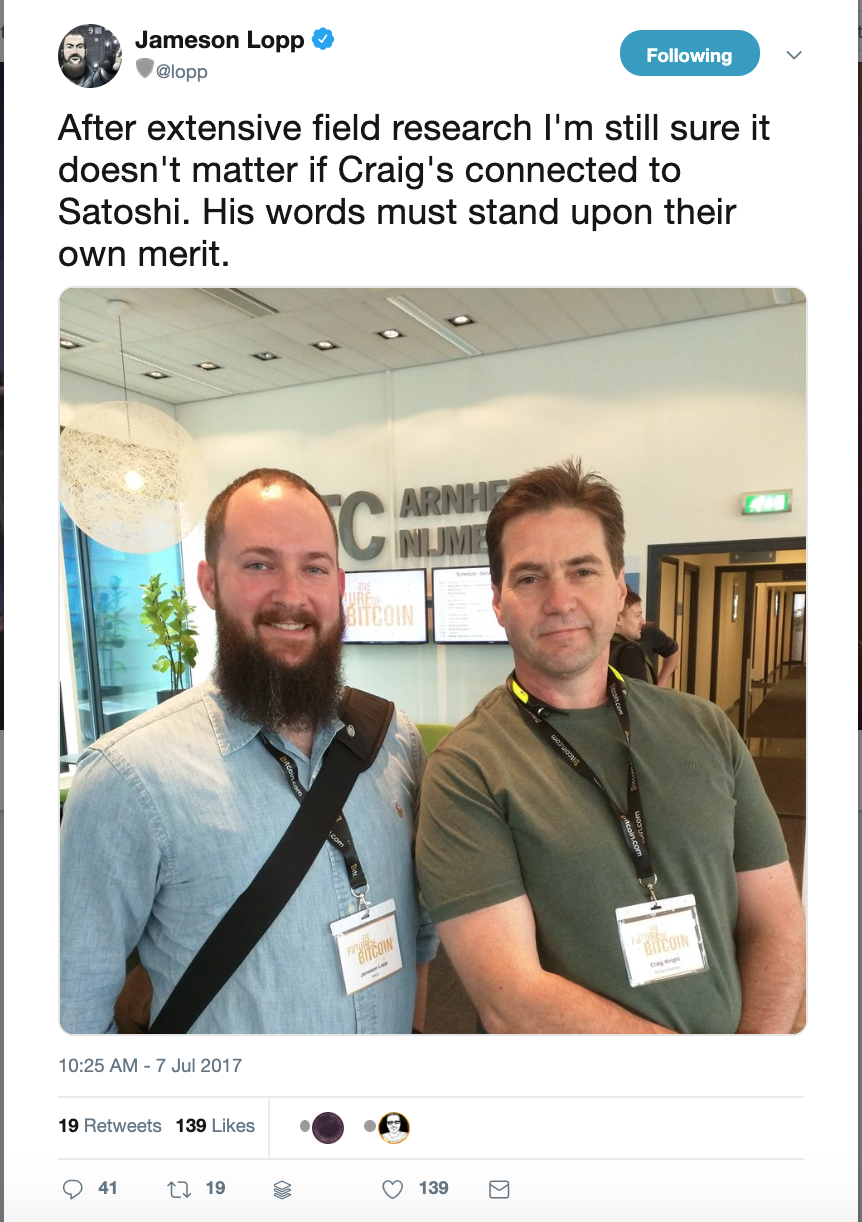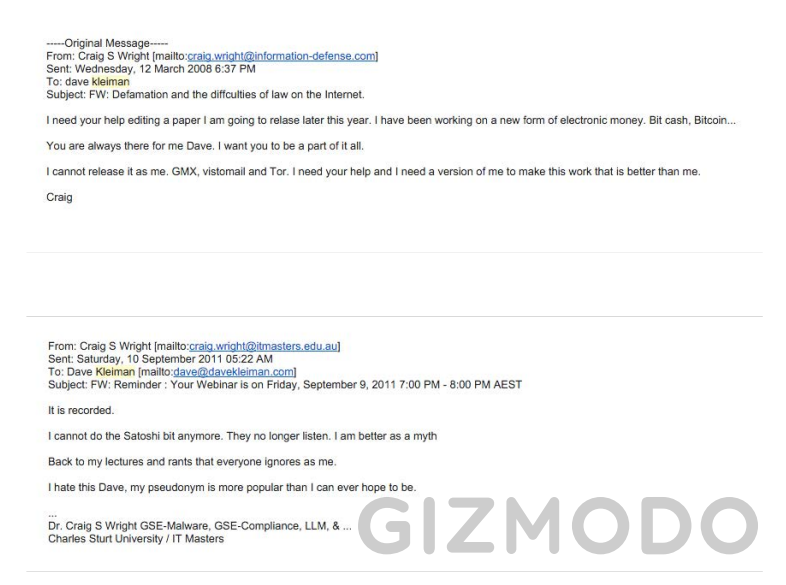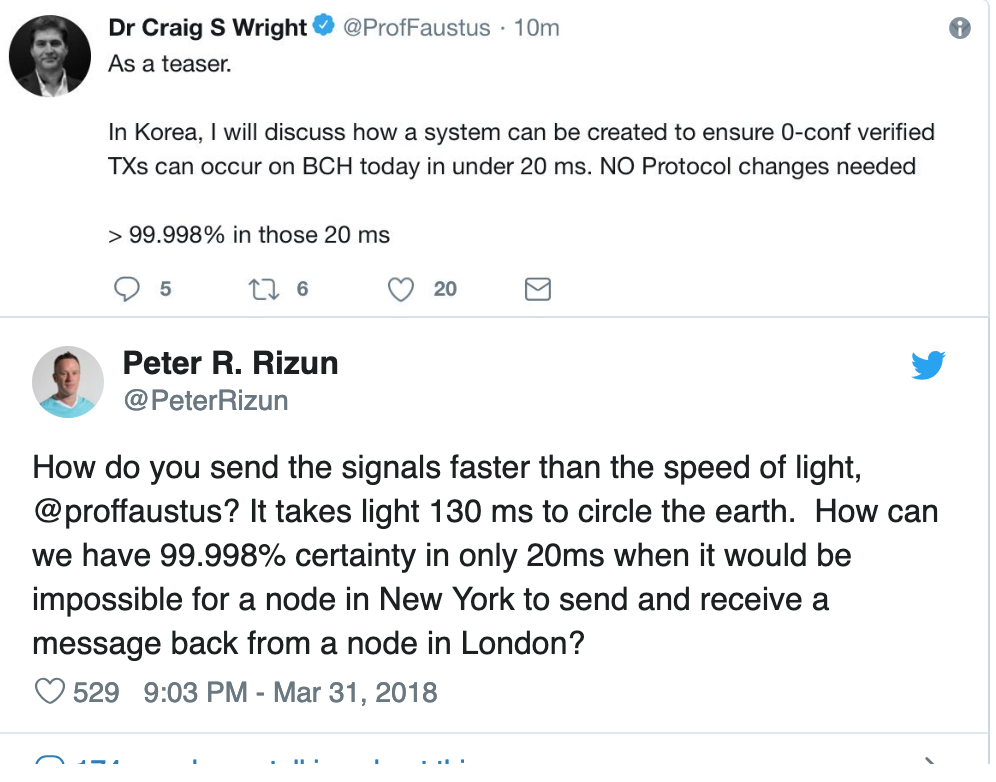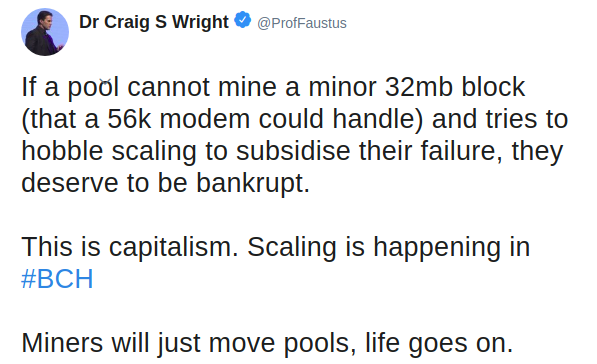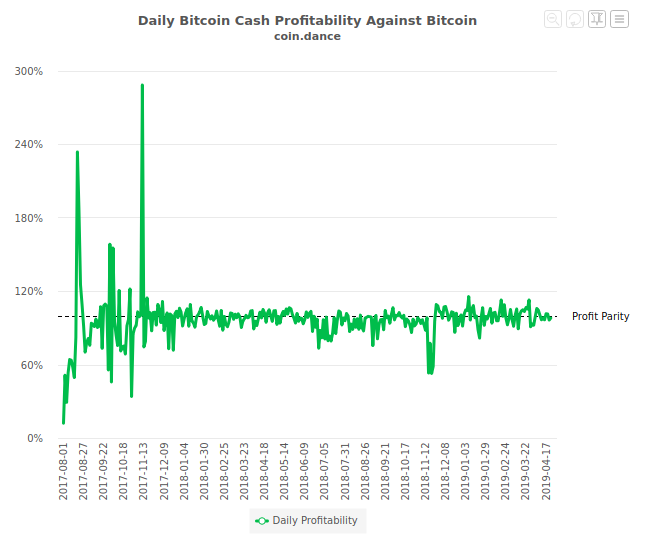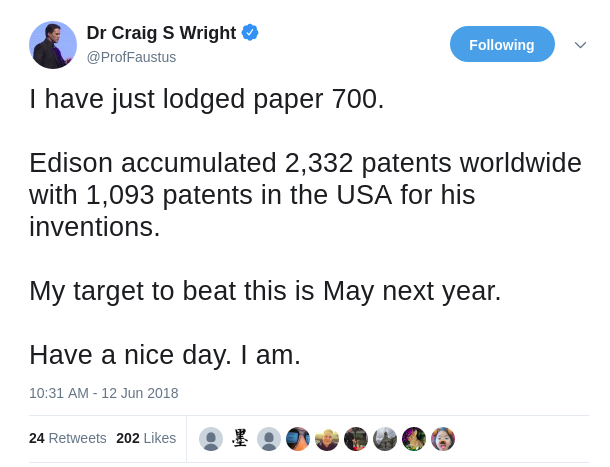Op Ed:有多少错误让一个Wright?
在其他文章和社交媒体上,有些人在个人层面上质疑Craig Wright的角色,并试图建立与手头事项无关的欺诈性商业行为模式。虽然我的研究让我检查了这些指控,但我决定将这篇特定文章的重点缩小到仅仅因为它与Wright声称他是比特币的创造者中本聪有关。
2015年,克雷格·赖特(Craig S. Wright)作为一个神秘且充满争议的人物在比特币爆发,他声称自己是比特币的假名创造者中本聪(中本聪)。
实际上我在2014年曾多次在推特上与他交叉路径(当时他使用了现在已删除的句柄@dr_craig_wright),但我发现他的大部分推文都难以理解,我一般都不认他。
但不是每个人都这样做
Gavin Andresen在宣布他确信Craig Wright是中本聪之后
2017年,我在荷兰阿纳姆举行的比特币未来会议上亲自会见了Craig Wright。当他没有站在带着相机指向他的舞台上时,他更加风度翩翩,尽管他看起来仍然相当顽固,并且倾向于以一种让我发现比启发更令人困惑的方式说话。
多年来,我曾认为赖特会诋毁自己,以至于我们不再需要听到他的声音,但他坚持了下来。最近,他已经采取了合法的威胁,公开宣称赖特不是Satoshi的人。但我认为中本聪不再对比特币有任何权力 – Satoshi真实身份的问题只是一种无关紧要的好奇心。
我认为相关的问题是赖特是否可信:在考虑了这篇文章中提供的证据之后,你可以做出更明智的决定。
以下代表了Wright与比特币及其社区的历史相关的大部分相关信息,我可以找到,编译成一种格式,希望能够方便地参考。
Satoshi Evidence and Lack Thereof
Wright有可能以某种方式与Satoshi和比特币的创造联系起来吗?好吧,这不是一种可能反驳的联系 – 而赖特似乎也在指望这一点。
他最近对有关这种联系缺乏证据的问题的回答是,他不会屈服于“披露他的财务记录”的压力,而且关键所有权并不能证明什么。据说他的工作应该是足够的证据。
我们所知道并且可以证明的是:
- 他有可疑陈述和活动的记录历史。
- 他有着夸大自己学历的历史。
- 他在他的着作中提出了许多技术错误,这些错误使他对比特币和互联网技术的理解受到质疑。
- 他的写作风格(根据文本分析)和风度似乎与这些着作存档的Satoshi的风格不同。
- 赖特曾经说过:“我是一名律师,这(金融法)是我的专业领域,”当被问及金融法如何应用于比特币时,真正的Satoshi说,“我不是律师,我可以'我可能会回答这个问题。“
- Wright曾经说过:“我从来没有说比特币是一种加密货币”,但Satoshi多次称比特币为加密货币。
- Wright曾经说他是一个“学术编码员”,他不知道“真实世界的编码”,但Satoshi说过,“我的代码比用文字更好。”
- 2008年,就在匿名中本聪出现前六个月,赖特发表了一篇公开帖子,称“匿名是懦夫的盾牌,它是用来捍卫谎言的封面。我的生活是开放的,我几乎不关心我的隐私。“
- 2011年2月,他似乎根本没有意识到比特币,因为他正在考虑启动一个由黄金支持的支付系统。
- 2011年8月,他开始在他的着作中提到比特币,但他称之为“比特币”,而Satoshi没有在电子邮件或论坛帖子中使用空格或资本C.在早期的代码库中有一个“BitCoin”实例,但Satoshi自己后来纠正了大写。
- 他主动在山上购买和交易硬币。 Gox在2013年和2014年。
- 他曾经问过为什么你会在刻录地址中使用X而不是零。 中本聪发明了用于这些地址的Base58编码方案,它有意排除看起来相似的数字和字母,例如零和字母O.
- 他曾经声称比特币的块大小是在块头中设置的(事实并非如此)。
- 他曾经声称,由于双线性配对属性,Satoshi选择了secp256k1曲线,但是Satoshi曾经说过“我没有找到任何推荐曲线类型的东西,所以我只选了一个。”
- 在接受GQ采访时,赖特声称,“我没有动过(任何比特币)。我已将它们发送给Hal Finney和Zooko,就是这样。完全停止。”但在2009年,中本聪向开发人员Mike Hearn发送了82.51 BTC。
- 到目前为止,他未能提供简单的加密货币证据,证明他在承诺这样做之后控制属于Satoshi的密钥。
- 他提供的加密货币“证据”已经被众多专家广泛揭穿,包括Patrick McKenzie,Dan Kaminsky和Robert Graham。
赖特的一些支持者声称,以上所有内容都是一个精心设计的诡计的一部分,让我们离开这条路,他被迫宣布他的身份为Satoshi。
我们从历史邮件列表帖子中可以看到,Wright参与了cypherpunk和infosec社区。因此,Wright比大多数人更适合摆出Satoshi候选人。但即使作为这些社区的一员,他也没有获得多少积极的声誉。

Wright告诉英国广播公司新闻说:“我将在他的”出来“即将结束时说:”我将在相机上拍摄一次,我将永远不会再在相机上,在任何电视台或任何媒体上。自从“。
正如您将从以下记录的证据中看到的那样,赖特没有坚持这一承诺。相反,他一直处于聚光灯下,经常暗示他创造了比特币,同时避免(或未能)实际证明它。
未能建立关键所有权
2016年5月3日,赖特答应花一些Satoshi的硬币。他还在他的博客上发表了这篇(现已删除)的帖子,他承诺会展示他是Satoshi的非凡证据。
在“The Satoshi Affair”(伦敦书评)中,作家Andrew O'Hagan描述了2016年5月4日发生的以下事件:“新的(和最终的)证明会议旨在消除疑虑,”当赖特应该向安德森和BBC记者发送比特币交易时:
“赖特担心早期区块链存在安全漏洞,这会让他冒险移动比特币,让他暴露于剥削或盗窃之中。我的消息来源后来说安德烈森了解这个问题,并证实它已被修复。但赖特继续担心,并表示极不情愿提供最终证据。然后他突然离开了房间,没有回来。“
在第一次尝试以密码方式证明他有Satoshi的钥匙之后,他道歉并且好像他已经完成了。
资料来源:http://archive.is/OxGhp
令人难以置信的加密货币签名
2016年,Wright撰写了一篇关于如何验证加密货币签名的冗长博客文章,其中他粘贴了签名而未指定其验证的消息。没过多久,专家们就确定有问题的签名来自比特币交易,而不是签署一些Jean-Paul Sartre的签名。
GitHub的撰稿人Patrick McKenzie总结了这篇文章:
“Wright的帖子是flimflam和hokum,经过几分钟的粗略审查,证明了一个有能力的系统管理员对加密货币工具的熟悉程度,但最终没有证明有关Satoshi的非公开信息。”
安全研究员和博客Dan Kaminsky解释了为什么他认为Wright提供的签名可能是欺诈性的:
“赖特假装他在萨特的写作中有Satoshi的签名。这意味着他有私钥,很可能是Satoshi。他实际拥有的是Satoshi在部分公共区块链上的签名,这当然意味着他不需要私钥而且他不需要是Satoshi。他只需要让你认为Satoshi在Blockchain之外签了别的东西 – 比如Sartre。他没有发表萨特。他发表了一份文件的14%。然后他会向您显示一个哈希,它应该总结整个文档。这是个谎言。这是从区块链本身提取的哈希。“
编剧乔丹·皮尔森和Lorenzo Franceschi-Bicchierai在一篇名为“Craig Wright的新证据,他是中本聪是没用的”主题文章中表示赞同,他说“赖特只是重用了2009年由Satoshi执行的比特币交易中的旧签名。”
改变证据?
看起来好像在2014年和2015年之间的某个时候,赖特可能已经回过头来改变了一篇旧的2008年博客文章,看起来他似乎在2008年一直致力于加密货币。
原始(2014年快照)与改动(2015年快照)
Wired和Gizmodo在Wright的“郊游”中提到的证据之一就是Satoshi是Satoshi的PGP键,但最终被揭穿,因为它显示键已经过时了。
此外,Reddit上的一个侦探声称,根据注册信息,Wright给Kleiman的一封电子邮件中显示的域名 – 赖特是Satoshi的一个关键“证据” – 直到2009年1月23日才被Wright收购:10个月在电子邮件上的日期之后。
这些电子邮件被发送到Gizmodo,后者推测泄密者很可能是Wright本人。
更多Debunked Cryptographic签名
2018年11月3日,有人在StackExchange上询问有关计算Satoshi在第170块将BTC送到Hal Finney的交易签名的问题。不到两周后,Bitcoin Cash在ABC和Satoshi Vision客户之间进行了争议后者由赖特和nChain支持。
在分叉后的24小时内,Twitter @satoshi帐户已经发布了几个月的Satoshi报价和白皮书摘录,开始发布不同寻常的推文,听起来很像他们来自Wright。其中一条推文(后来被删除)是签名的计算,但比特币开发人员很快解释了为什么它是欺诈性的:
正如比特币开发人员Pieter Wuille所指出的那样,“消息不是哈希并由'签名者'选择的ECDSA签名是不安全的。”这次签名者刚刚发布了“hash”,r,s元组。 ECDSA的哈希部分是算法的组成部分。如果验证程序本身未运行哈希,则安全性属性不会成立。
Jimmy Song写了一篇详细的文章,解释了包括Wright在内的任何人创造一些毫无价值但可信的签名会有多么容易。实际上,已经发布了一个工具,使任何人都可以轻松地以这种方式创建签名。
改变黑网与比特币白皮书
在2019年2月,赖特在推特上声称他曾在2001年向澳大利亚政府提交了一份研究论文,该论文与比特币白皮书完全相同。但是,已经有一份白皮书草案在公开发布在cypherpunks邮件列表上之前已经发布。这大概是落后的白皮书看起来像最终版本而不是草案,因为它包括了在2001年BlackNet论文发布七年之后才会做出的所有贡献。
资料来源:https://www.reddit.com/r/btc/comments/apc9c1/craig_wright_caught_lying_again/
Kleiman可疑比特币的案例
虽然没有与赖特声称他是Satoshi的证据直接相关,但是对Wright与计算机取证专家Dave Kleiman(他也被传言是Satoshi背后真实的程序员)的互动的审查提供了一些他对整体可信度和与之关系的见解。真相。
2018年,Kleiman的亲属在迈阿密的美国联邦法院对一家著名的律师事务所提起诉讼。该诉讼声称赖特通过伪造各种文件欺骗性地获得了Kleiman拥有的大量比特币。但是,有证据表明这些比特币的存在是非常值得怀疑的。
在2018年2月27日的一篇真实的WizSec博客文章中,Kim Nilsson证明了其中许多地址可以归结为其他人并归因于其他人。作者仅认定为“MtGox用户”的一个这样的地址(16cou7Ht6WjTzuFyDBnht9hmvXytg6XdVT)可能属于Roger Ver,并且在Roger的比特币政府网站上用于“投票”以支持各种陈述。事实上,WizSec博客文章的原始版本将其归为Ver,然后才更改为只说“MtGox用户”.Ver已被质疑此地址,但据我所知,他从未否认过它属于他。
Wright vs Satoshi睡眠/活动时间表
通过检查Wright在2009年和2010年期间发布的100多篇博客文章中的公共时间戳,并将它们与Satoshi在同一时期发送的电子邮件,论坛帖子和代码提交的800多个公共时间戳进行比较,我们可以获得一些关于每个人的睡眠模式。很明显,Wright从13:00到18:00 UTC一直处于非活动状态,而Satoshi从7:00到12:00不活动。因此,Wright似乎保持与居住在AEST时区(澳大利亚)的人一致的睡眠时间表,而Satoshi保持与EST时区(北美东海岸和南美西海岸的一部分)一致的睡眠时间表。虽然Wright可能会为每个身份精心维护两个不同的时间表,但Occam的Razor认为不同模式的原因可能是因为它们属于不同的人。
这些K线走势图的原始数据和计算可在此处获得。
技术错误和缺点
无论谁真正扮演中本聪,都引入了互联网时代迄今为止最优雅的项目之一。比特币的创建远远超过了它的时代,真正的Satoshi清楚地掌握了它所引入的技术概念,以及愿意承认他或她的知识中的差距。通过概述Wright已经证明缺乏技术知识的一些更值得注意的例子,假名Satoshi不容易证明的反复出现的特征变得明显。
赖特是nChain的“首席科学家”,但他经常提出可疑的技术主张。
除了上面的推文,Wright声称互联网带宽将超过本地总线速度,这是不可能的,因为两台计算机之间的互联网连接两端的数据都存储在硬盘上。
来源:https://archive.fo/SwjEf
他还曾声称拥有56K调制解调器的用户可以在9.5分钟内下载32 MB。它实际上需要80分钟,这表明Wright错误地将每秒位数与每秒字节数混淆。
资料来源:https://archive.fo/xvf7l
他也对DNA提出了一个非常奇怪的主张:
资料来源:https://archive.fo/5it3L
科学和数学课的时间一条人类DNA由大约200亿个Atom组成。 DNA仅由五种元素组成:碳,氢,氧,氮和磷。因此,如果我们可以构建一个五元存储系统,那么一条DNA链可以存储多达1万亿比特(~125 GB)的数据。目前估计整个互联网的数量为5到10个zettabytes,所以这个声明已经至少减少了十个数量级。
Wright曾经声称有符号整数没有无符号整数那么有用,这就是为什么更复杂的逻辑不能在比特币上发生的原因。据说,这是因为溢出无符号整数的能力“能够实现数学函数”。
同时,大多数计算机科学家会告诉您整数溢出会导致数据丢失和意外的应用程序行为 – 应该避免应用程序的可靠性和安全性。
Wright还声称secp256k1可用于双线性配对。这一说法遭到了Andrew Poelstra(Blockstream的密码学家)和Vitalik Buterin(以太坊的创造者)的反驳。
资料来源:https://archive.fo/Kwyfb
他没有证明任何这样的事情。相反,他声称Bitmain可能拥有刻录地址的私钥。当然,这是一个不可能的主张,并且数学是无可辩驳的 – 它将需要大约2的计算来强制私钥,并且在任何合理的时间范围内,世界上没有足够的计算能力来做到这一点。 。
赖特的许多出版作品都经过了严格的审查。 Peter R. Rizun分析了赖特写的关于自私挖矿的一篇论文,并确定它包含大量错误和不明确的假设:
“作者试图解释比特币挖矿的一些非常基本的方面,但由于粗心的符号,他的方程式中的多个错误,以及对比特币挖矿意味着'无记忆'意味着什么的基本误解而失败。”
同样,Paul Sztorc回顾了Wright写的一篇关于隔离证人功能的文章,题为“隔离证人中的规模幻觉”,并发现它充满了错误和荒谬的主张。
“最大的问题是交易所方程式(PY = MV),CSW向后解释。他最初正确地使用'P'作为'价格水平'(即BTC /东西),但随后他将其切换为'货币价格'(这将是东西/ BTC)。所以…它倒退了。换句话说,关于速度的一切都与他说的相反。“
百万比特币问题:为什么要打扰?
鉴于手头的证据,Nik Cubrilovic发布了一个有意义的解释。他的帖子已被删除,但存档版本可以在这里查看。
Cubrilovic说,在他作为Satoshi“出游”之前,赖特曾参与针对澳大利亚政府的退税计划。 Wright在多个不同的法律实体下经营:Hotwire,DeMorgan,CloudCroft,Panopticrypt,Coin-Ex,Denariuz,Tulip Trading,Craig Wright R&D,Permanent Success Limited,信息防御,Integyrs,全球网络安全研究所以及其他几十家公司如本法院成绩单第53页所述,2014年Hotwire管理员报告。该报告详述了三个相关要点:
1)Hotwire如何运作:
“公司的主要活动是收购各种电子学习和电子支付软件,并就该软件和相关实体拥有的软件开展研究和开发工作。”
2)Hotwire据称如何获得资助:
“董事们已经建议股东以实收资本认购3000万美元,这是通过比特币注入的。”
3)资金的使用情况如何:
“公司将其权益如下:
– 2900万美元从Wright Family Trust('the Trust')购买软件;和
– 100万美元用于资助日常交易活动。“
Wright所做的是建立一家公司,目的是对从Wright自己的信托中获得的电子学习软件进行研究和开发。
Wright将向该公司注入3000万美元的比特币资金,其中2900万美元将支付给Wright信托收购该软件,其中100万美元将用于支付运营成本 – 包括悉尼办事处和40名员工。
在公司采取的下一步行动中,结构的目的变得清晰:
“除了产生一系列费用外,公司还提交了2013年9月季度的商品及服务税申报表,申请退税金额为310万美元(”商品及服务税退税“)。经过各种讨论和通信后,ATO于2014年1月20日向公司发出通知,通知其意图扣留退款,等待进一步核实交易和比特币处理。
Wright投资2900万美元到公司的销售税(GST)部分有资格获得退款。因此,通过在您控制的实体之间改变比特币,可以触发销售退税(以现金支付)。然而,目前还不清楚是否有3000万美元的比特币首先被洗牌。
另一家莱特实体DeMorgan在澳大利亚发起了有史以来规模最大的研发税务特许权索赔 – 根据其自己的新闻稿。但是,我无法找到任何证据支持这一说法。
研发税务特许权是澳大利亚的一项计划,投资研发的公司有资格获得每消费一美元45%的退税。根据福布斯的报道,声称属于这种支出的超级计算机并不存在,因此退款请求可能被视为企图提出虚假声明。
据“纽约客”报道:
“解释Hotwire明显破产的接收文件表明,由于Mount Gox的崩盘,Wright正在声称损失。”这引用了2014年Mt.崩盘事件。 Gox比特币交易所显示,赖特一直试图向当局解释他的比特币损失一段时间。“
为什么赖特说他是聪士? Cubrilovic认为Wright只是简单地制作了一个过于复杂而无法放松的谎言网,所以现在他必须继续进一步。
“当他需要从投资者那里筹集资金,或者说出他的方式摆脱问题时,Wright才能成为Nakamoto。众所周知,中本聪正在坐拥价值数十亿美元的比特币。“
另一方面,Cubrilovic认为Wright可能不希望他的被称为中本聪的身份变得更广为人知,以免他最终“撞到某人”,他可能会对他的要求提出质疑并需要某种形式的证据。
“就为什么Wright被Nakamoto的故事公之于众而言,我可以提供一些理论。首先是有太多人发现,其中一人,可能是心怀不满的员工或投资者,决定泄露(新闻)作为报复行为。第二个理论是赖特,知道它已经结束了他的公司并且当局正在关闭,他自己编造了泄漏,作为在伦敦开始新生活的第一步,因为中本聪(Wright逃离澳大利亚并且没有返回)。
根据奥哈根的说法:
“在袭击Craig Wright的房子前几周,当他的名字仍然没有公开与中本聪有关时,我收到了来自公司Davis Wright Tremaine的洛杉矶律师Jimmy Nguyen的电子邮件(自我描述)作为“娱乐,科技,广告,体育和其他行业公司的一站式商店”。 Nguyen告诉我,他们打算与我签约,写下中本聪的生活。 “我的客户已经获得了生活故事权利……来自化名中本聪背后的真人 – 比特币协议的创造者,”律师写道。 “这个故事将引起公众的极大兴趣,我们预计,一旦Satoshi的真实身份被揭露,这本书项目将产生重要的宣传和媒体报道。”
我发现这个片段特别有趣,因为Jimmy Nguyen是一位专注于娱乐和知识产权的律师,后来成为nChain(一家科技公司)的首席执行官,而之前的首席执行官Stefan Matthews成为董事会主席。总部位于加拿大的转账公司nTrust的创始人兼首席执行官罗伯特麦格雷戈(Robert MacGregor)认为,nChain的计划不是建立技术,而是通过出售知识产权来实现巨大退出。
据O'Hagan在“The Satoshi Affair”中称,Wright据称被支付了大笔资金以“出来”作为Satoshi:
“在最初的怀疑之后,尽管对赖特的态度略有厌恶,但MacGregor被说服并与2015年6月29日签署的Wright达成协议.MacGregor说他确信赖特是比特币的传奇失踪父亲,他告诉我他的想法是在协议起草的后期,坚持将Satoshi的“生命权利”纳入协议的一部分。赖特的公司债务如此沉重,以至于这笔交易对他来说就像救援计划一样,所以他同意了一切,似乎并没有真正研究他必须做些什么。根据Matthews和MacGregor后来给我的证据,在几个月内,这笔交易将使MacGregor的公司损失1500万美元。
“这是对的,”马修斯今年二月说。 “当我们签署协议时,给了莱特的律师150万美元。但我的主要工作是与新律师建立合作关系……并将Wright的知识产权转让给nCrpt' – 新成立的nTrust子公司。该交易有以下几个部分:清除阻碍赖特业务重新站起来的未偿还债务,并与新律师合作,就转让任何非公司知识产权达成协议,并与之合作律师们获得克雷格的故事权利。从那时起,'Satoshi启示'将成为交易的一部分。 “这是商业化计划的基石,”马修斯说,“大约有一千万人陷入澳大利亚的债务并在伦敦建立起来。”
“nCrypt背后的男人总是很清楚这个计划。他们将把赖特带到伦敦并为他建立一个研发中心,约有三十名员工在他的指导下工作。他们将完成他的发明和专利申请的工作 – 他似乎有数百个 – 并且整个批次将作为中本聪的作品出售,他将作为项目的一部分被揭露。一旦打包,Matthews和MacGregor计划以超过10亿美元的价格出售知识产权。麦克格雷戈后来告诉我,他正在与谷歌和优步,以及一些瑞士银行进行对话。马修斯告诉我,“计划是把它打包并出售。” “该计划从未实施过。”
但谁是神秘的恩人资助所有这些活动?有迹象表明,一位名叫Calvin Ayre的人是加拿大亿万富翁,最著名的就是建立在线博彩公司Bodog。再一次,根据“The Satoshi Affair”:
“Calvin Ayre是团队经常黯淡的话题之一。当我第一次见到赖特时,他称他为“安提瓜的男人”。麦格雷戈在我们早期的会议中从未提及过他。当我后来告诉他拉莫纳在安提瓜岛提到一个大个子时,他说他不介意谈论他,但他没有再提起他的名字。当今年2月,他们带着赖特去安提瓜进行鼓舞人心的谈话时,我给马修斯发了电子邮件,询问我是否也可以来,他没有回复。 Wright,在一个低潮时刻,后来问我是否告诉MacGregor他们是那些让猫从袋子里走出来的人。我说那不是他们:马修斯首次提到艾尔的名字。当我和马修斯一起出去吃饭时安提瓜会议正在安排,他自由地提到了艾尔,没有要求它没有记录。 MacGregor从未详细介绍艾尔的参与情况,但两人经常访问安提瓜让我对这种联系的程度感到疑惑。像往常一样明显的马修斯总是谈到艾尔,好像他是整个事件的首饰,尽管我没有其他证据表明艾尔只不过是一个感兴趣的观察者。有趣的是,nCrypt的唯一股东(一股价值一英镑)是在安提瓜注册的nCrypt Holdings。“
根据2017年路透社的文章,nChain Holdings被出售给位于马耳他的High Tech Private Equity Fund SICAV plc。然而,该新闻稿中列出的该基金的网站已不复存在。
“nChain通过电子邮件回复路透社提出的问题,称Ayre和Wright在出售之前或之后都没有股份。该公司表示,该公司此前收购了赖特的资产和知识产权,现在他担任首席科学家。“
nChain的陈述可能意味着几件事 – 也许两个人都没有直接拥有股份,但他们间接通过一系列其他法律实体。 (查看下面提供的K线走势图,了解更大的图片。)
这也可能意味着,如果赖特有任何利益,他已经“售罄”,现在只是试图完成出售知识产权的总体规划 – 或者另一种理论是,他只是试图耗尽时间,让它看起来就像他正试图这样做。
根据路透社的一篇文章,“一位知情人士表示,3亿美元投资于nChain,但目前尚不清楚这段时间。”
Matthews关于投资者的有趣引用:
“与我合作的人有能力决定这是一个价值3000万美元的糟糕决定并将其写下来。”
Elmo Keep在Splinter发表的一篇文章总结了O'Hagan的“The Satoshi Affair”:
“总的来说,这件作品增加了对赖特的指责,他指责全世界范围内广泛而复杂的欺诈行为使全世界相信他是中本聪,以便摆脱他在澳大利亚与税务局增持的价值数百万美元的债务。其他债权人。如果这是一个骗局,它现在似乎包含了大量的共谋者和/或受害者,包括那些习惯于帮助赖特出游的媒体。“
这篇文章似乎暗示赖特可能正在进行一种复杂形式的预付费诈骗或亲和骗局,他利用自己的信誉来说服投资者将他们的钱分配给未来回报的承诺。
另一种理论是Stefan Matthews是前面提到的安排的关键,他将Calvin Ayre带入了这个特定的计划。
根据O'Hagan的说法,Matthews是Wright已经认识10年的澳大利亚IT专家,因为他们都曾在在线博彩网站Centrebet工作过。马修斯后来去为Bodog工作。 Matthews was also a director for Wright’s company DeMorgan, so they likely remained in close contact. In “The Satoshi Affair,” Matthews is quoted as saying:
“I get what I get paid by Calvin (Ayre). Calvin is the only allegiance I have, then and now.”
If you look into Ayre’s background, he has been building an “offshore” gambling empire that takes advantage of jurisdictional arbitrage in order to offer services that, when combined, are arguably illegal in some countries. By spreading around his operations, he has been able to not only maintain them in such an adversarial environment but to grow them into a huge operation. He’s a shrewd businessman who is well versed in exploiting legal loopholes. As Ayre once described his operations in a Forbes interview:
“We run a business that can’t actually be described as gambling in each country we operate in. But when you add it all together, it’s Internet gambling.”
Court records show that Ayre’s not without his own problems though, as he was a fugitive from the IRS and other U.S. authorities due to money laundering charges filed in 2012. During the five years he'd spent on the run, U.S. authorities seized over $68 million in assets from him but eventually allowed him to plead to a misdemeanor charge in return for dropping all of the felony charges.
In my opinion, Ayre is in a situation where a censorship-resistant and unseizable cryptocurrency is highly desirable. Even when he first began operating in the 1990s, his gambling site was one of the few that didn’t use third parties like Western Union to transfer money — it sent checks directly to users. If I was Ayre, I’d want all of my gambling sites to use cryptocurrency and I’d want to store a significant portion of my wealth in cryptocurrency.
Why would Ayre choose to go the Bitcoin Cash (and later Bitcoin Satoshi Vision) route rather than just using the already well-established Bitcoin network? Was he convinced that BSV was better suited for gambling, or that he’d be better positioned to influence BSV’s development? Or was it that Ayre was already incredibly invested in Wright’s success and was ambivalent about the technical details? Or could Ayre’s mining operations simply have been a useful way for him to launder money? Freshly minted coins are pretty much impossible to tie to illegal activity. Electricity goes in and untainted money comes out.
Economically rational SHA256 miners should mine the most profitable network since switching costs are fairly low. We can observe from the above charts that BSV miners appear to not be economically rational – they are leaving money on the table, so to speak. While BCH miners appear to drop off the BCH network (and probably switch to mining BTC) when it becomes more profitable to do so, BSV miners have been consistently mining at a loss, in comparison to if they were mining BTC instead. This begs the question: Are BSV miners actually irrational or is there another factor at play that makes it rational for them to pass over an opportunity for greater profits? One plausible explanation is that as of April 26 2019, over 80 percent of the BSV hashrate is controlled by 2 pools: CoinGeek (owned by Ayre) and BMG Pool (owned by nChain) and that they are mining suboptimally in order to keep up appearances of strength. This reasoning makes sense given that BSV is built upon an ideology driven by Nakamoto Consensus: “He who controls the hashrate controls the network.”
In the chart below, an internet sleuth on Reddit theorized about a possible web of relationships.
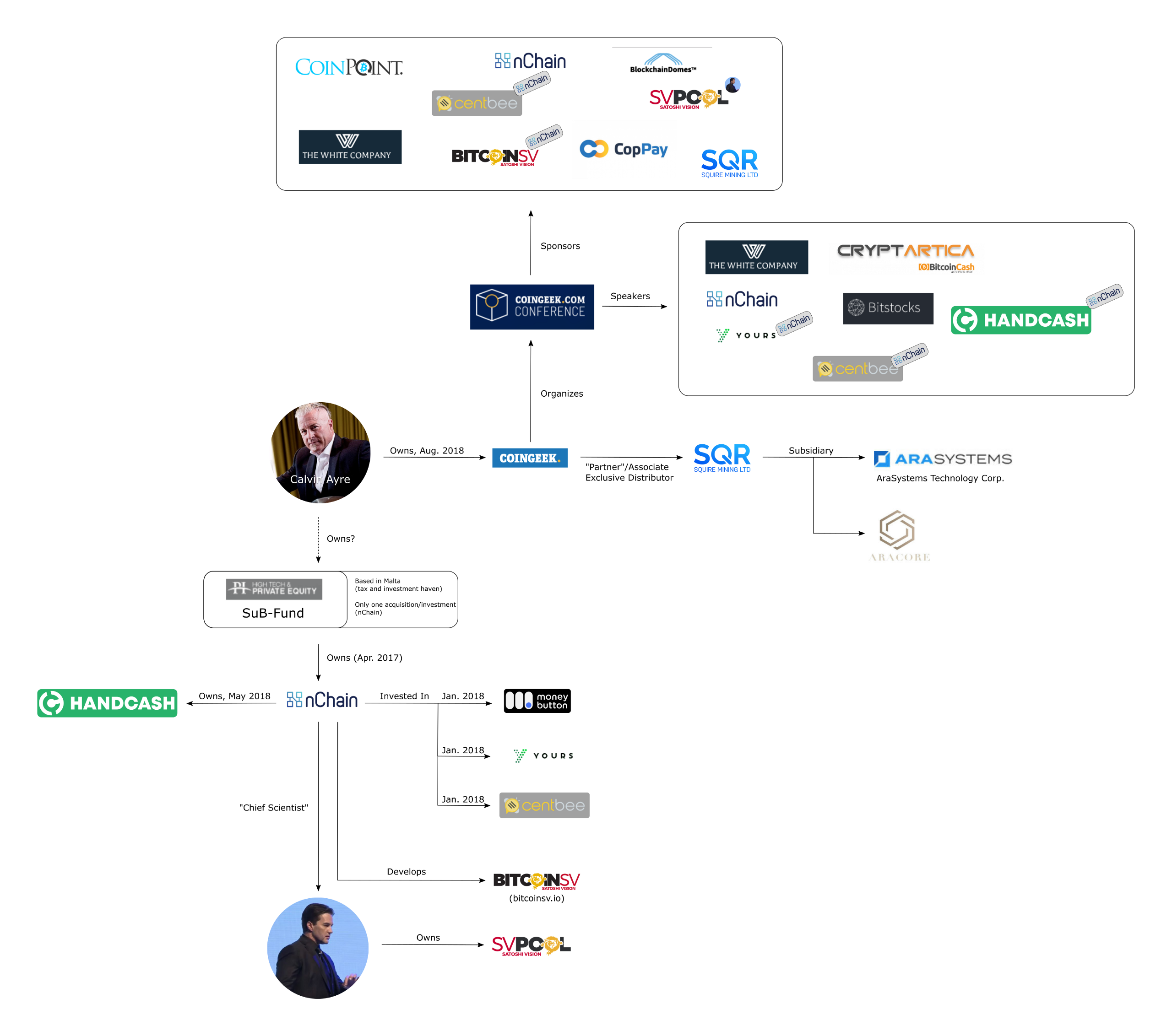
Wright has been prolific in his efforts to file patents for other blockchain- and computer-science-related work. These patents would be much more interesting to potential investors if filed by the man behind Satoshi, possibly serving as motivation for Wright’s claims.
Wright has been filing patents for a few years under EITC Holdings, nChain Holdings, NCIP Holding and nTrust. Filings of his have been found at the Intellectual Property Office of the United Kingdom, European Patent Office, U.S. Patent and Trademark Office and Taiwan Intellectual Property Office. A (now-deleted) site called bitcoinpatentreport.com detailed some of the activity.
At the time of this writing, a total of 264 patents by Wright’s companies have been published by the British patent office, while the European patent office shows 167 applications for nChain. PatentScope sees 296 applications, while Google Patents shows a total of 363.
On March 7, 2019, nChain CEO Jimmy Nguyen wrote that nChain had filed its 666th patent application. Note that filings are generally published with a time lag of up to 18 months, so we’ll have to wait another year to know for sure.
Source: https://archive.fo/vrhBm
Source: https://archive.fo/PPER9
These tweets with specific claims of patent applications filed are interesting because they conflict with the number claimed by nChain’s CEO in March of 2019. Wright claims 700 patents filed as of June 2018 and 1,000 filed as of December 2018, while Nguyen claims 666 as of March 2019.
While nChain may not be filing as many applications as Wright claims, it certainly is filing a lot. But filing applications is not the same as having patents granted.
From a cursory review of some of the applications, it appears that patent examiners are finding prior art for many of nChain’s claimed novel inventions; you can see some of the patent examiner opinions here.
Take, for example, Wright’s patent application for a threshold signature scheme. The patent examiner determined that 31 of the 34 claims of novelty were, in fact, not novel. Or this patent application for UTXO time locks, for which the patent examiner determined 14 of the 17 claims were not novel.
In February 2017, Wright submitted a patent titled “Agent-based Turing Complete Transactions integrating feedback within a区块链 System,” basically trying to patent any computer program that uses a blockchain as its data store. In a Medium post dated September 4, 2018, Jonathan Toomim completed an in-depth analysis of Wright’s proposal and demonstrated ways in which P2Pool, Ethereum and Counterparty could be considered prior art.
Evasion of Criticism
On June 30, 2018, Wright blocked me on Twitter and made this post.
Source: https://archive.fo/D4zrc
I found this to be a bit odd because I had muted him many months before and stopped interacting with him after I challenged one of his technical claims about the node network graph of Bitcoin Cash. Instead of answering my straightforward question, he countered with a bombardment of questions of his own that did not appear particularly relevant.
In the following weeks and months he continued blocking quite a few people, even those who supported Bitcoin Cash, perhaps in anticipation of nChain planning to push a contentious hard fork for Bitcoin SV.

Among Wright’s lengthy list of claimed accomplishments, there are quite a few academic achievements, including PhDs that he has used as the basis for his title of “Dr.”
In 2017, he pulled a stunt at a Bitcoin Meetup in Zurich, where he brought a “wheelbarrow of degrees” on stage. Photos of these degrees and certificates were subsequently published on nChain’s website.
As we can see from this list, Wright’s only PhD appears to have been completed in April 2017 at Charles Sturt University (often ranked around number 30 in Australia and number 800 globally), which is where most of his degrees appear to have come from.
Wright’s now-deleted LinkedIn profile also claimed a “PhD, Computer Science 2009–2012” from Charles Sturt University, but the school put these claims in question with a media release:
That PhD in computer science is not listed among his degrees. Nor is the Masters in Systems Development that he has claimed. Neither is listed on CSU’s alumni education verification site either.
That same LinkedIn profile claimed that he’d earned a “Doctor of Theology, Comparitive Religous (sic) and Classical Studies 1998–2003” from “Guess” — he later stated that his theology studies were through SOAS (University of London’s School of Oriental and African Studies).
Source: https://twitter.com/ProfFaustus/status/1083339312219996160
However, it seems clear from my research that he has never published anything (such as a PhD thesis) through SOAS as its research archives hold nothing with his name on it.
Nevertheless, in 2015, Wright remotely participated in a Bitcoin conference and claimed he had “a couple doctorates.” It’s quite clear that Wright had given himself the title of “Dr.” and used it for several years before rightfully earning it.
This media statement issued by CSU further clarified that, despite Wright stating he was a lecturer and researcher at the university, “(b)etween May 2011 and May 2014 Mr. Wright was an adjunct academic at CSU. Adjunct academics undertake unpaid academic work and are not formally employed by the University.”
I have been unable to verify Wright’s LinkedIn claim that he earned a “Master of Science (MSc), Finance (Quantitative Finance)” in 2015–2017 through the University of London (presumably through SOAS again). A Mashable request for academic records appears to have been unfulfilled. I sent my own request and SOAS replied that I needed written consent from the individual in order to have the information released. This seems like a flaw to me; you’d think that academic institutions would want to help students accredit their academic credentials.
Military Service
Wright has referred to his time in the military on several occasions. I have looked into the record of his service and the tasks he allegedly performed at that time in order to confirm his claims.
The earliest record that I’ve been able to find of Wright referencing his military service in the cypherpunk community dates back to 1996, when Wright added a post to the cypherpunks mailing list:
“The few months I was unemployed after I left the military because of a confict (sic) of interests I earned money by doing whatever I could get.”
In 2008, Wright made a reference to this time in his life on a public mailing list:
“In 1989 I started a B.Eng/BSci double degree. I dropped out of the University of Queensland in 1992 (after my 3rd year). I have a reason for this. I had cancer. I though (sic) that it was better to go back to my studies after I knew I would live. Sorry, but we all have priorities.”
Years later, according to “The Satoshi Affair,” Wright said of his time in the military:
“‘They locked me in a bunker … and I worked on a bombing system. Smart bombs. We needed fast code, and I did that.’”
I found Wright’s claims about his military service intriguing, mainly because military service creates a lot of public records. So I strolled on over to the National Archives of Australia to see what information it would release to me. It took several months of painful bureaucratic back and forth, but I managed to retrieve 82 out of the 177 pages of documents on file for Wright. They are available here.
What do Wright’s public military records show?
- He was in the Australian Air Force Cadets at age 15 in 1986.
- He applied to the Australian Defence Force Academy to train as a pilot in 1987 but was rejected. Oddly enough, the psychologist’s report filed with this application is blank. It is possible that the completed one was withheld.
- He was a student at the University of Queensland from 1988 to 1989.
- He applied to the Royal Australian Air Force in 1989 and was accepted to a nine-year officer program with a sponsorship to the RAAF undergraduate program to study electrical engineering. The sponsorship offer noted that “should you fail to progress academically for whatever reason … you may be required to apply to repeat the year at your own expense.”
- He started his first semester in 1990 as an Officer Cadet.
- He passed one class, “Law of War,” in the first semester.
- Oddly enough, there is no mention of any engineering or math classes, but perhaps these records were withheld.
- A (hard to read) handwritten letter released by the archives appears to state that “Officer Cadets Bone and Wright were asked to show cause why they should be provided with continued RAAF sponsorship as they had failed semester 1/90.”
- Wright did send a letter regarding his undergraduate sponsorship standing later that year, but it was withheld by the archives.
- He went on SLWOP (special leave without pay) on March 15, 1990.
- He was discharged October 19, 1990, for “Reason 4.” (I’ve not been able to verify what “Reason 4” means.)
It’s interesting, to say the least, that this man who claims to be a lifelong academic with more than a dozen degrees appears to have failed out of his first semester in the RAAF, according to these public records.
Is it likely that he was given the responsibility to write code for bomb guidance systems as a first-semester cadet? Did he leave the military due to a “conflict of interest”? Records show he was at the RAAF in 1990, so what about his claim that he was studying at the University of Queensland from 1989 to 1992?
What Now?
Wright’s threats through his London-based lawyer against multiple posters may or may not wind their way through the court process. The lawsuit against Wright in federal court in Miami will continue; in fact, Wright recently was scheduled to sit for testimony in London, so we will be interested in learning more about that.
I, personally, am highly doubtful of many of Wright’s claims. He’s had four years to come forward with proof that he is Satoshi, and I, for one, am not satisfied.
On the bright side, it would appear that Wright has painted himself into a corner. He is now the figurehead of a fork of a fork of Bitcoin, operating in a tiny echo chamber that will be incredibly difficult to grow. In fact, it appears that there is a growing movement among exchanges to delist the BSV asset. It will be interesting to see how Craig & Co. make their exit — will it be with a bang or a whimper?
Wright thrives on attention, and the unfortunate result of this post is that it is a catch-22 — it will bring him more attention, at least temporarily. I believe we’ll all be better off if we let this chapter of Bitcoin come to a close.
Additional Sources
Numerous sources have been reviewed in connection with this op ed, and many are linked throughout. Below are links to further extended posts and compilations.
Andreas Brekken’s “Cult of Craig” compilation, now maintained at https://craigwright.online/ and https://www.stopcraigwright.com/
Bitcoin Wiki’s entry on Craig Wright
/u/Contrarian__’s plethora of Reddit posts
Jonald Fyookball’s compilation of Wright’s history
Nik Cubrilovic’s analysis of Hotwire
This is an op ed by Jameson Lopp. Opinions expressed are his own and do not necessarily reflect those of Bitcoin Magazine or BTC Inc.


